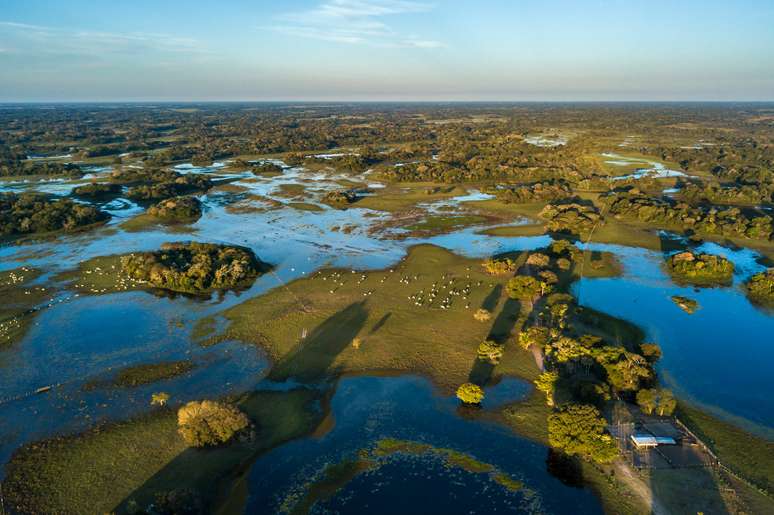The Pantanal is known for being one of the richest and most varied Brazilian biomes when it comes to its fauna.
Summary
The Pantanal is a biome located between Brazil, Paraguay and Bolivia, which is home to approximately 132 species of mammals and 463 species of birds, as well as having areas of floodplain and a tropical climate. Its main economic activity is tourism, where the Tuiuiú stands out as a symbol of the biome.
Whether for its references to pop culture – such as the telenovela Pantanal, recently remake on Rede Globo -, for its typical cuisine or for its music, Pantanal occupies a place in the collective imagination, becoming one of the most remembered and recognized places by the Brazilians.
Despite being one of the smallest biomes in the country, it is considered one of the best preserved, as well as being extremely rich, especially in terms of fauna.
To honor this biome, Brazil celebrates Pantanal Day every year on November 12th.
What is the Pantanal?
The Pantanal is one of six Brazilian biomes. When compared to the others – Amazon, Caatinga, Cerrado, Atlantic Forest and Pampas – the Pantanal is considered one of the smallest biomes, covering approximately 2% of the Brazilian territory.
Furthermore, the Pantanal is known for sharing space with the Caatinga and the Cerrado, integrating with these biomes and also with the tropical forests of the territory.
In 2001, the biome was recognized as a natural heritage of humanity by the United Nations Educational, Scientific and Cultural Organization (UNESCO).
How big is the Pantanal?
The Pantanal has a surface area of approximately 220 thousand km², of which 120 thousand km² is on Brazilian soil – and the rest is divided between Paraguay and Bolivia, countries that border Brazil and which also have the Pantanal among their biomes.
Due to its vast size, the Pantanal spans 22 Brazilian cities in the states of Mato Grosso and Mato Grosso do Sul.
Where is the Pantanal located?
The Pantanal is divided between Brazil, Paraguay and Bolivia. In the latter two Spanish-speaking countries, the Pantanal has a different name: it is called Chaco.
In Brazil, the biome is located in the southwest of Mato Grosso and west of Mato Grosso do Sul, which includes 65% of the Brazilian Pantanal.
Among the cities that have the Pantanal as a biome there are:
- Barão de Melgaço, in Mato Grosso;
- Cáceres, in Mato Grosso;
- Poconé, in Mato Grosso;
- Aquidauana, in Mato Grosso do Sul;
- Corumbá, in Mato Grosso do Sul.
What are the main characteristics of the Pantanal?
The main characteristic of the Pantanal as a biome is that it is one of the most floodable plains on the planet, in which, during the flood season, up to 80% of its territory is flooded, which happens due to the low slope of the terrain , which, on average, is only 100 meters tall.
For this reason, many areas have low fertility, which can harm the region’s agricultural activity.
The Pantanal is also known for its variety of fauna: almost all the animals that live in Brazil are concentrated there.
What is the fauna of the Pantanal?
Due to the influence of other biomes in its area, the fauna of the Pantanal is considered extremely rich and includes the largest number of bird species on the entire continent.
According to the Brazilian Institute of Geography and Statistics (IBGE), the flora of the Pantanal is composed of:
- 132 species of mammals, including deer, jaguars, bats, tapirs and capybaras;
- 85 species of reptiles, the largest variety of reptiles are alligators;
- 463 species of birds, such as toucans, macaws, tuiuiú, carão;
- 35 species of amphibians;
- 263 species of fish, including the jaú, considered the largest in the region, the pacu, the painted fish, the catfish, the traíra and the golden fish.
Furthermore, it is in the Pantanal that it is possible to find the anaconda, the second largest snake in the world, which can measure up to nine meters in length.
Despite its richness, the Pantanal suffers from illegal animal hunting and fishing, which damages local biodiversity.
What is the flora of the Pantanal?
The flora of the Pantanal is also influenced by the biomes that integrate with it, so the cities it passes through present a great diversity of plants and trees.
Therefore, among the plant species present in the Pantanal, it is possible to find plants migrated from the Cerrado, the Amazon and the Atlantic Forest.
The flooded plains of the Pantanal are home to water hyacinths, yerba-de-santa-luzia, utricularia and cabomba, vegetation typical of these places.
What is the climate in the Pantanal?
The Pantanal is known for its rainy summer and dry winter. This is due to the fact that the biome is located in an area with a tropical climate.
The rains usually occur between October and March; Between April and September, the absence of rain and bad weather tend to attract tourists, contributing to tourism, which is one of the main economic drivers of the region.
What is the economy of the Pantanal like?
The economy of the Pantanal can be divided into three parts: tourism, fishing and livestock.
Every year, Pantanal tourism attracts people from all corners of Brazil and the world. The high season falls outside the rainy season and it is common for tourists to stay on hotel boats in the cities of Cáceres (MT) and Corumbá (MS).
Fishing usually takes place from March to October, while piracema takes place between November and February, a period in which fishing is prohibited to allow the fish to migrate and reproduce.
Finally, livestock activity is also part of the Pantanal’s economy: farmers saw these places and their flat areas as an ideal place to raise their livestock.
What is the symbolic bird of the Pantanal?
The symbolic bird of the Pantanal is the Tuiuiú, also called Jaburu or red-breasted Tuim.
This bird is characterized by a naked neck, colored black and red, and white down.
In addition to being found in the Pantanal, Tuiuiú is also found in Mexico and Uruguay.
Source: Terra
Rose James is a Gossipify movie and series reviewer known for her in-depth analysis and unique perspective on the latest releases. With a background in film studies, she provides engaging and informative reviews, and keeps readers up to date with industry trends and emerging talents.






